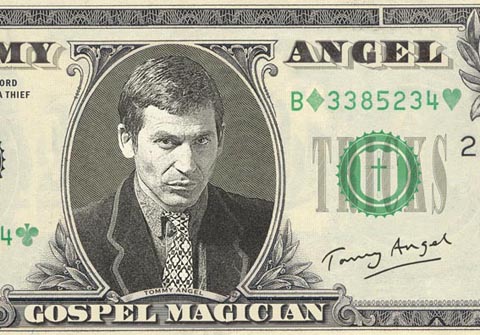![]()
![]()
![]()

IN THE MOOD FOR MAKING AN ART OF MONEY
The IMF summit provides fodder for Biennale works, writes PARVATHI NAYAR
Published September 8, 2006
Singapore Business TimesDuring next week's International Monetary Fund
(IMF)-World Bank annual general meeting, issues of money, globalisation
and funding - among others - will be in the air and on the table. We look
at how some of these issues are represented in - or have affected - the
artistic events happening in the city during the period.
Usually, Art and Money form an unholy alliance - whether as the obscene
amounts paid in auctions for the works of deceased artists or as the negligible
amounts earned by living artists. But, sometimes, the alliance transcends
its boundaries to become something else altogether - when money is the
actual raw material for art. The niche practice was made famous by artists
such as Fiona Hall - who shredded dollar bills to create fragile, woven
birds' nests - or JSG Boggs - who meticulously drew one-sided US dollar
notes that he exchanged for goods worth the denomination of the note.
Examples of this sort of play with money-art in the ongoing Singapore
Biennale are made more subversive, thanks to the timing. For our Biennale
cannot be seen as just site-specific - it is time-specific as well.
Its juxtaposition with the IMF/World Bank meetings offers a specially
legitimate prism with which to view artworks dealing with forms of money
or currency. There are interesting slippages; Biennale curator Sharmini
Pereira points out, for example, that currency loses its 'value' when
rendered as art, yet the act creates something with a value of its own.
Money is also part of our visual culture. Ms Pereira talks of 'the iconography
of state and religion' present on the bank notes of a country, which artist
and magician Jonathan Allen exploits so well. For his Singapore performance,
he printed large quantities of one dollar bills emblazoned with his alter
ego Tommy Angel. Over the past few days, he has been 'put-pocketing' these
dollar notes into the pockets and bags of unsuspecting Singaporeans. He
has 'placed' around 1,500 such notes already, and has assistants who will
continue the work even after he leaves.
'Magicians understand our psychological connection with money,' he says.
For money has a potent role as a prop in magic, and viewers are particularly
goggle-eyed when magicians 'materialise' money as the proverbial rabbit
from a hat.
Allen's sleight-of-hand distribution of bank notes is also suggestive
of the way in which ideas - and especially the more sinister theologies
- are put into circulation among people. Tommy Angel himself was created
post-9/11 as a way to put a face to the more negative aspects of emerging
Christian fundamentalism; he is a Billy Graham meets David Copperfield
via Donald Rumsfeld sort of character.
Talk to Allen, and he takes you on a 'magical' trip through the history
of the magic arts via the history of gospel magic to his own roots in
magic - a grandfather who was a metal worker and who made double-headed
coins for him. Allen also dispenses related trivia: one of the - contested
- derivations for the term 'hocus pocus' is the saying hoc est corpus
('This is the body'), spoken during the Catholic Mass.
Allen says his fake 'parodic notes' critique many discussions, such as
the 'homogeneity of capital that an organisation such as IMF represents.
This is a fiction, for currency has specific local powers. My work is
not directed against IMF; however, I did want to contribute something
that could unsettle the discussion around money.'
Among the other Biennale money-art artists is Jeon Joonho. In part, he
plays with the power structures embedded in the US dollar notes that become
the background of his video artworks The White House and In God We Trust.
The latter is a phrase taken from the US dollar bill, and questions the
whole business of nation building with simple devices such as people futilely
asking for directions to the Independence Hall. In the more powerful White
House, the artist 'white washes' out the windows on the facade of the
White House as it appears in the US$20 bill.
Obviously, the power of the dollar note does not lie in the value of its
material - paper; interestingly enough, before 1971, the US dollar was
pegged to gold at a fixed rate. The idea of money's 'value' is contested
in the work of Hossein Golba: a gold ingot inscribed with the words 'Diversity
is Value'. It asks the question, what is it that we value - the diversity
of human life or this human invention we are obsessed with, i.e., money?
The artist is planning to further commodify this work by creating 1001
copies of it for sale.
Gustavo Romano has dealt with the exchange value of money in past performances
of the work Time Notes. However, he altered the performance in direct
response to Singapore, says Ms Pereira; the artist walked down the commercial
heart of Singapore, Orchard Road, letting go of 'bank notes' - and recorded
the responses that ensued.
Less directly, Jennifer Wen Ma offers a certain commentary on money with
her video work Alms. Alms-giving is a tenet of all religions, but you
could argue that the giving of money - at any level - is a problematic
act; nations and individuals often get locked into uneasy and ultimately
destructive debt situations.
Allen suggests a curious parallel between Money and Art when he talks
of money as an abstraction that has been forced into representation. I
walked away from the interview with the artist/magician not just with
much to ponder about the currencies of art, magic and religion - but also
with a Tommy Angel dollar bill that had been put-pocketed into my bag.
PARVATHI NAYAR Sept 2006
info
>![]() <
back
<
back